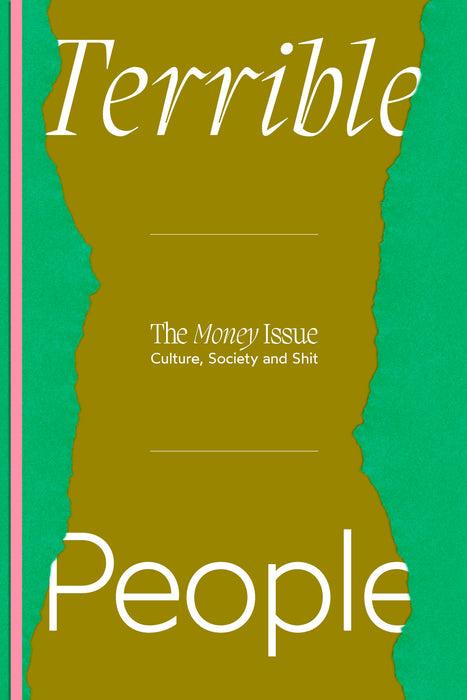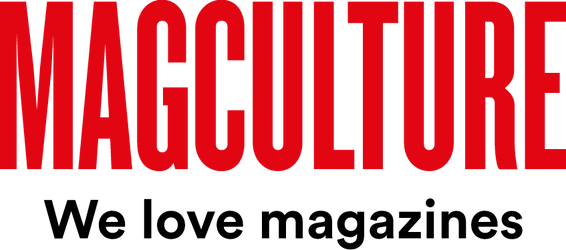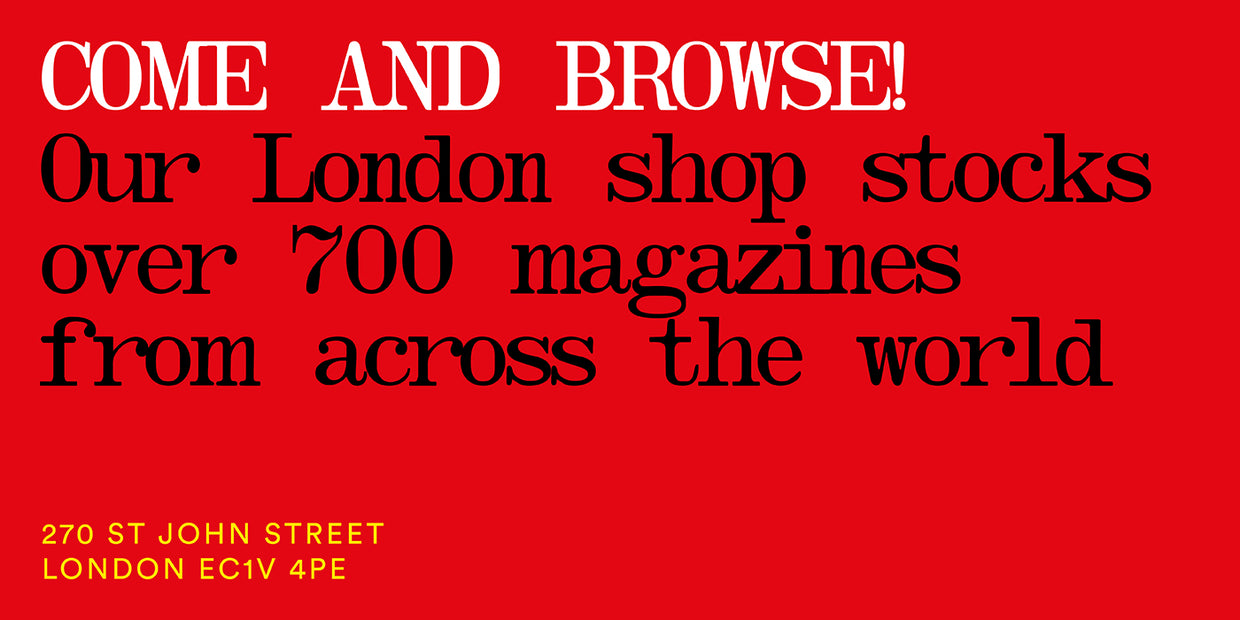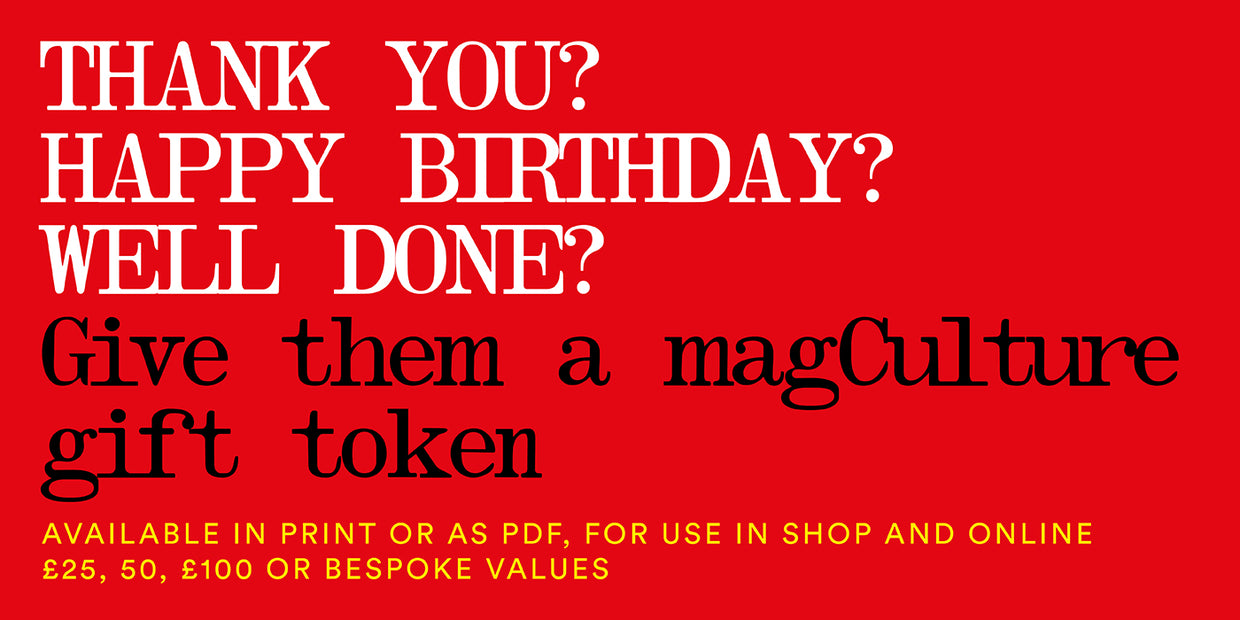

Oriane Pawlisiak, Terrible People
The seventh issue of Terrible People is about to arrive in shops, themed ‘Money’ and sporting a new, brighter design. Art director Oriane Pawlisiak reveals the new look as she discusses her inspirations and working week.
Oriane studied graphics at London’s LCC, before working at a number of magazines in the UK and France. She launched her magazine— subtitled ‘Culture, Society and Shit‘—in 2017, and continues to produce it while art directing for craft brands.
What are you doing this morning?
I work from home on Mondays, so I like to ease into the week with a slow start. I wake up around eight, put on some music, and slowly start getting ready (emphasis on slowly). The soundtrack usually spans a wide range of rap genres—a solid blend of French, English, and Arabic. Then I make myself a cup of black tea as I start going through my emails, sitting on the floor of living room. (Yes, I have a sofa, but I prefer the struggle.)

Describe your work environment
When I’m not at the office (three days a week), you’ll usually find me on my computer, either sitting on the floor (again) or at my standing desk. The latter is my official workstation, tucked into a little alcove I adore. It’s completely hidden from the rest of the room, a curated corner of indie mags and graphic inspiration, bathed in natural light by the afternoon. I do have an office chair. (Do I ever use it? Once again: no.)

Which magazine do you first remember?
I grew up with brothers, so GQ was always within reach when I was a teenager, and I was fascinated by it. The content seemed broader, less gender-coded than ‘woman’ magazines were at the time, and the design felt less restricted—I loved watching how it evolved over time. I actually had my first work experience in publishing at GQ France (Condé Nast) years later. Even though the content is more globalised today, I still follow all the international editions of the mag—and I’ve got a real soft spot for the art directions of the British and Middle Eastern ones.

Aside from yours, what’s your favourite magazine/zine?
Hard to pick THE favourite, but I’ll give you one of the many I loved to discover: Reflections magazine. Does it happen to be another project Roxy (Roxy Merrell, editor-in-chief) worked on? Yes is it! It’s a zine exploring the world from a sensitive lens, with a stunning design by Tjade Bouma.
What other piece of media would you recommend? And why?
I listen to a lot of podcasts. I’m obsessed with conversational podcasts—and the more offbeat, the better. À bientôt de te revoir and Floodcast are hands-down my top picks.
I also love podcasts starring so-called ‘ordinary’ people people doing anything but ordinary things. I’m fascinated by personal stories and the diverse perspectives people have on society. No wonder why we started Terrible People, really. Transfert is a great one, for anyone who understands French.

Describe Terrible People in three words
Witty+Bold+Insightful=Terrible People
But we usually describe it by: If you’ve ever wondered why people do some terrible things, so have we…
The magazine has a lot of fun making the serious point that we humans can be shit. What’s the most terrible thing you’ve known somebody do?
It probably wasn’t the worst thing ever—but it was the cherry on top of the terrible cake that pushed us to create the magazine with Jen (Jennifer Link, Project Manager), eight years ago.
One morning, we found ourselves spiralling into a collective rant with friends about the daily nonsense of human behavior: people shoving their way into a packed tube when another's due any second, or tossing rubbish next to the bin... It was just fascinating (and desperately annoying) to see how a handful of inconsiderate people could make public space feel like chaos. From these small incivilities came the best jokes, and as we zoomed out, we realized human behavior—at every scale—was an endless source of absurdity. So we made a magazine about it.

Do you worry that the magazine might encourage readers to act their worst? Or do you hope it’ll inspire their best?
As surprising as it may be for a magazine called Terrible People, our goal is to inspire the best in people! We aim to make our readers question what’s truly terrible and reflect on their own behavior in society by highlighting two kinds of terribleness: what we’ll call subjective terribleness and morally objective terribleness.
Subjective terribleness covers all things that may feel terrible because one comes from a different background, and the sense of wrongness stems from misunderstanding. In our section La crème de la crème of weird customs, we explore cultural differences that might seem terrible at first glance, and try to put them into perspective, swapping snap judgments for a bit of curiosity (assuming intolerance is so last season).
The rest of the magazine delves into what we might call morally objective terribleness, exposing universally questionable human behaviour (racism, LGBTQIA+ phobia, eco-skepticism…). Because these topics are often complex and heavy, we approach them through a playful satire lens. We truly believe humour is the most powerful tools to spark a new reflection on serious issues, empowering people to engage without feeling preached to.

You’ve just redesigned the magazine; what have you changed?
This redesign is our second one, and it’s more of an evolution than an ‘aesthetic makeover’. We grow, and so does the magazine, which is why we got into this pattern of questioning our editorial content and design every three years, to make sure it still aligns with the quality we aim for. Is the pace of the magazine working? Are all the papers we use serving our design well? How can we prevent the elastic bands from breaking with time?

On the cover, for example, we wanted to be bolder in translating a terrible behavior: in our last three issues, the concept was based on someone handling our immaculate white magazine with dirty hands (above). We went one step further from this new Issue, ripping the cover in the middle (there is also a non-ripped version, for people who couldn’t stand it.) We also gave it more depth with a textured paper, and the use of a metalic pantone was a way to colour-match the Money theme.
Typography plays a key role in this redesign, as seen on the cover. We’ve paired a bold, expressive serif font with a soft, rounded sans-serif, reflecting well the diversity of human nature.

Please show us one spread that sums up how the magazine works
We’ve always put people at the heart of the magazine—so with the redesign, we took that literally. Our interviewee now gets special treatment, featured in the elastic-bound booklet at the center of the magazine. For our new Money Issue, we sat down with the under-qualified detectives behind the non-crime crime podcast Who Shat On The Floor At My Wedding? hoping to uncover some insights into human absurdity.

What has publishing magazines taught you that may be helpful to anyone else planning to launch one?
Just go for it. Starting a magazine is all about taking that first leap, and I believe that applies to any business: don’t wait for perfection before jumping in. It is intimating thinking about everything that comes with launching a mag (social media presence, distribution, ads…), but break down the big picture into smaller steps, and you’ll find your way.
So just launch the damn magazine! If you're passionate about your subject, there’s always an audience for it. This is especially true in London’s indie publishing scene, where people are freer to express themselves than anywhere else I think. When you love a topic, it shines through in your magazine, and readers will connect with it.
What are you most looking forward to this coming week?
1. Spending time with my niece, Albane (coolest person to be)
2. Seeing Gabriel Moses’ Selah exhibition
3. Starting to brainstorm ideas for issue eight
buystufffrom.terrible-people.com
Buy your copy from the magCulture Shop





